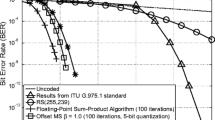Conclusions
The final selection of a structure for a code converter depends to a great extent on the potentialities of the system elements under consideration and represents a compromise between many such contradictory factors as conversion time τ of a single binary digit, reliability T, cost G (or amount of equipment V), etc. If the importance of these parameters is represented as a system of weights, g1∶: g2∶: g3 then finally the “quality” of any j-th version can be represented by the sum
where ΔGmax, ΔTmax, and Δτmax are the differences between the best and worst values of parameters in the versions under consideration; ΔGj, ΔTj, and Δτj are the differences between the best values and those obtained in the j-th version. The final selection of the version is obtained from the maximum value of σ.
For a preliminary selection of versions in evaluating (27) a simpler criterion is more convenient
since G and T have a functional relationship to the existing system of elements and to the equipment complications which are determined by the number of logical elements in the decoder, corrector, and in the shift and carry circuits. The expected timeτ j is evaluated from the structure of any complete tetrade of digits as the sum
where β(inj) is the maximum number of any trigger's operations between cycles k and k+1 of the converter,γ j and δj are the maximum number of logical elements which pass consecutively the shift and correction signals respectively, Δτι and Δτt are the switching durations of the logical and tetrade elements.
Similar content being viewed by others
Literature cited
J. Eckert, “Univac-Lark. New step in designing computers” [Russian translation], Kiberneticheskii Sbornik, No. 3 (1961).
M. A. Kartsev, Voprosy Radioélektroniki,12, No. 18 (1959).
M. M. Sukhomlinov and V. I. Vykhovanets, Number Code Converter [in Russian], Izd. Tekhnika, Kiev (1965).
D. Cohen, Control Eng.,11, No. 3 (1964).
V. N. Zamrii, Author's Certificates Nos. 184013 and 184014, Byull. Izobr., No. 14 (1966).
V. V. Meer and G. A. Antonov, Aviatsionnaya Promyshlennost', No. 4 (1967).
N. I. Gorelikov, V. V. Efimenko, and I. I. Korshever, Avtometriya, No. 3 (1965).
V. V. Efimenko, Avtometriya, No. 2 (1965).
R. B. Harley, Logical Transistorized Circuits [Russian translation], Izd. Mir, Moscow (1965).
Additional information
Translated from Izmeritel'naya Tekhnika, No. 11, pp. 33–39, November, 1968.
Rights and permissions
About this article
Cite this article
Meer, V.V. Design principles of code converters for digital high-speed processing systems. Meas Tech 11, 1489–1497 (1968). https://doi.org/10.1007/BF00986031
Received:
Issue Date:
DOI: https://doi.org/10.1007/BF00986031




